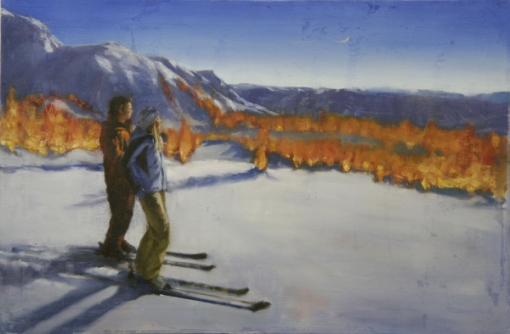Philip’s work will be on display at Borough Gallery & Studio as part of the exhibition “The Place You Hang Your Hat” until Friday, December 4th.
Borough Gallery & Studio: Many of your paintings look like scenes from a fable, or fairy tale. Like a fable, are there morals that underpin your work? Are you attempting to morally educate your audience?
Philip J. Hardy: Good question. I’m apprehensive to say that they are moralizing although many times they are inspired by fables. Personally I don’t have any really strong moral convictions. I think that most moralizing material usually has some political agenda. I don’t want to impose some ideals on anyone. I’m not trying to recreate culture or society. I wouldn’t want that responsibility even if I had the power to do that. One of my original goals when I started out as an artist was to make a painting people would look at for more than two seconds. I am interested in investigating established notions through visual means to gain a better understanding of myself and my relationship to the world. If my audience also receives something of the same effect when they look at my work is not really any concern or mine. I don’t want to be locked into any one specific way of thinking, mostly because I feel it would hinder my ability to make art that is universal. Prescribing to a specific moral code would probably make my life a lot easier though.
BGS: Where do your concepts come from? Is there a lot of research, trial
and error and juxtaposition, or does a concept suddenly strike from
nowhere?
PJH: I try not to think about concept too much. I like technique, aesthetics or execution more than concept. It’s a personal preference. I want the concept to come out of the technique rather than the technique to come out of the concept. It is not that I feel the concept is not as important or subservient to technique. I feel that more people currently making art take the approach of trying to express some concept using a technique that develops as a result of the concept.
My ideas don’t come from one source. It’s pretty arbitrary. Most things are pretty arbitrary. They are usually influenced by things going on in my life. Sometimes dreams. Things I am reading, watching, listening to, doing, etc. I like that. I’m interested to see how my work is influenced by my personal experiences and how people read them. I don’t really want to think too much about it. I prefer to respond, like an animal or something. I wish I could just turn off my analytic brain a lot of the time. I don’t know if that’s important but it helps me make my work and not worry too much about how well it will be received by other people. It’s fun not to really care.
BGS: It sounds like transcendence is a goal you have while painting, to kind of push away the self. Do you study Buddhism, or other religious/spiritual practices? Are there any influential texts/thinkers that shape your art?
PJH: I’m not religious. I don’t read spiritual texts. I have studied different religions. I live in a christian dominated culture so its pretty difficult for me to not be influenced by it at all. Not everyone believes in Jesus but most people believe in spirituality or some God type figure. It’s a basic human desire to believe that there is an after life or some cosmic judicial force. It’s a comforting thought. I am atheist. I don’t believe there is a God but I can still be involved in the discourse. Religion is so important to so many people that it is difficult to ignore the effect it has on culture.
BGS: Vermont happens to be the least religious state in the country. Do you think art is a way to fulfill needs for meaning and spiritual desires,or is it something else completely? Is art in conflict/competition with other mediums (mass media, gyms, science, academia) that may also be attempting to fill in for things once part of a religious practice?
PJH: Art doesn’t have one singular purpose. It can be used for many reasons. It can be used as a way to fulfill spiritual desires. I don’t think my work has any real important meaning in it. I think it expresses that people have a desire to be fulfilled spiritually through art. I don’t pretend to know what the meaning of life is or what happens when we die. I wish I did know. I might be happier. Religion is very powerful. I don’t think art can compete with religious practice; making it is very difficult to replace it.
Everything is in conflict with everything else. One person might be an avid gym goer and another an accomplished scientist. The scientist and the gym goer most likely have conflicting ideas on what makes their lives meaningful. Generally scientists do not believe athletic displays are more important than scientific discoveries. These two people are competing for the same resources. Resources are limited. One of these people is going to acquire more resources because the culture they live in emphasizes the value of one over the other. One of these two people is going to feel that their lives are more meaningful as a result. This is vaguely similar to the conflict between Christians and Muslims, or capitalists and communists.
BGS: What was a memorable meal that you had? Pleasurable or otherwise.
Haggis. I visited England and the English people there were trying to prove to me that English food is terrible. They proved it to me beyond any doubt.
For more information on Philip J. Hardy go here. See his work in person at Borough until Friday, December 4th.



Leave a comment